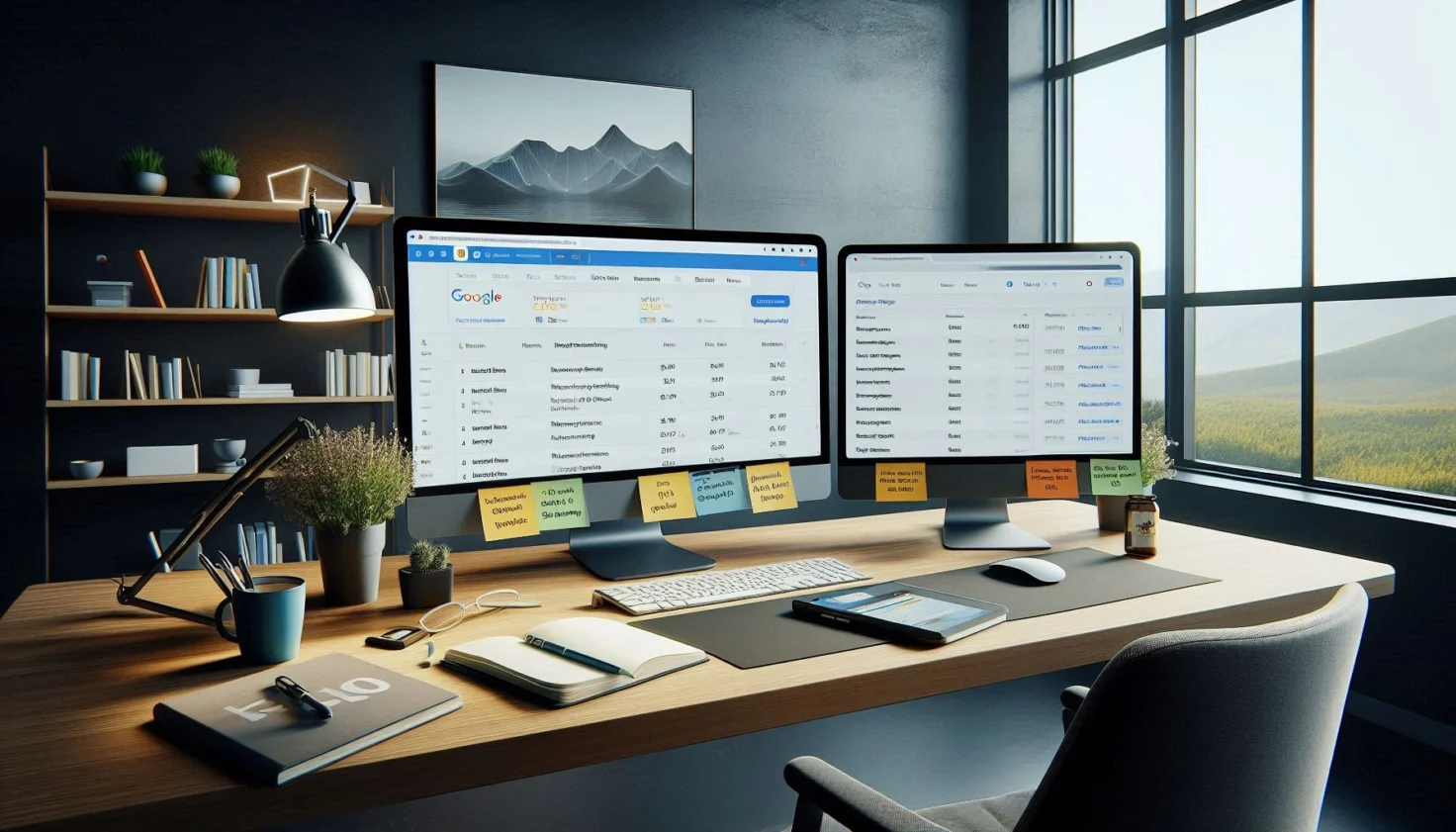Ever wondered why some websites top Google while others are hidden on page ten? This question led me into the world of SEO when I started in digital marketing.
Forbes says search engine optimization is great for brands to reach their goals without spending a lot. Google explains SEO as making your content easy for search engines and users to find naturally.
The importance of SEO hit me when I saw it’s more than just tricks. It’s about matching what people want with what you offer. Unlike ads, your SEO investment grows value over time.

Learning about SEO changed my online presence. If you want to boost your website, work with experts who know how to optimize it.
Table of Contents
Key Takeaways
- SEO connects user searches with your content naturally without paid advertising costs
- Forbes recognizes SEO as a cost-effective method for driving traffic, leads, and sales
- Google defines SEO as helping search engines understand and users find your content
- SEO investment builds long-term value unlike temporary paid advertising campaigns
- Understanding SEO fundamentals forms the foundation of successful digital marketing
- Quality SEO knowledge helps websites compete effectively in crowded online markets
Understanding Search Engine Optimization Fundamentals
To master SEO, I need to grasp the basics of how search engines work. At first, I learned that successful optimization isn’t about tricking algorithms. It’s about working with them to give users what they’re looking for.
Search engines like Google are like advanced answer machines. They scan billions of web pages to build a huge database of information. This helps them match user queries with the best content online.
Modern SEO is all about meeting user needs. When I optimize content, I’m improving it for both search engines and website visitors.
What SEO Really Means for Your Website
SEO makes your website a discoverable resource for search engines. It’s like creating a roadmap for both search engines and visitors to find your best content.
When I use SEO strategies, I’m making my website’s purpose clear to search engines. This includes:
- Optimizing content structure so search engines understand your main topics
- Improving page loading speeds to enhance user satisfaction
- Creating clear navigation paths that help both users and crawlers find information
- Developing mobile-friendly designs that work across all devices
The goal is to attract the right visitors who are genuinely interested in what you offer. Quality SEO brings targeted organic search traffic that converts better than generic visitors.
How Search Engines Crawl and Index Your Content
Google uses automated programs called crawlers or bots to explore the web. These digital explorers browse through web pages, following links like a person clicking through a website.
Here’s how the process works:
- Discovery: Crawlers find new web pages through links from existing indexed pages
- Crawling: Bots analyze page content, structure, and technical elements
- Indexing: Useful pages get added to Google’s massive index database
- Ranking: Algorithms determine where pages should appear in search results
When Google crawls your site, it checks thousands of factors. It looks at your content quality, page structure, loading speed, and how well your pages connect. This helps search engines decide which pages deserve higher rankings.
I’ve learned that making my content easily crawlable is key. This means using clear headings, descriptive URLs, and logical site navigation that guides crawlers through my most important pages.
The Connection Between SEO and User Experience
Modern search essentials show that user experience and SEO success are inseparable. Google’s algorithms now prioritize websites that help users find what they’re looking for quickly and efficiently.
When I focus on user experience, several SEO benefits follow:
- Lower bounce rates: Engaging content keeps visitors on your site longer
- Higher click-through rates: Compelling titles and descriptions attract more clicks
- Increased dwell time: Valuable content encourages users to explore multiple pages
- Better mobile performance: Responsive design improves rankings and user satisfaction
Search engines track user behavior signals to understand which pages provide the best experience. Pages that load quickly, display properly on mobile devices, and contain helpful information tend to rank higher in Google search results.
This connection has changed how I approach SEO. I now focus on creating content that genuinely solves problems for my target audience. This user-first approach consistently delivers better long-term results than outdated SEO tactics.
💰 Want More Sales, More Clicks, More Growth? This SEO Freelancer Makes It Happen
Why SEO Matters More Than Ever in Today’s Digital Landscape
The online world has changed a lot, bringing new challenges and chances for SEO. Today, businesses need to think more strategically online. Every business owner finds it hard to stand out online.
Getting noticed in search results is more important than ever. Forbes research shows that SEO takes 6 to 12 months to see meaningful results. This means starting SEO early gives businesses a big advantage over late starters.
SEO brings high-quality traffic to your site. People who find you through search are looking for what you offer. They are more likely to become customers.

The Growing Competition for Search Engine Visibility
The fight for top spots in search results is fiercer than ever. Millions of new websites compete for space on search pages. Small businesses find it hard to keep up with bigger companies’ SEO budgets.
Google’s changes make this competition even tougher. Search pages now have more ads and dynamic results. This means fewer chances for businesses to get noticed through organic search.
It’s not just about ranking well. Even if your site shows up, you’re up against many search features. Your result must stand out among rich snippets and other enhanced listings.
| Search Result Type | Click-Through Rate | Competition Level | SEO Difficulty |
|---|---|---|---|
| Featured Snippets | 35-45% | Very High | Advanced |
| Top 3 Organic Results | 25-35% | Extremely High | Expert Level |
| Local Pack Results | 15-25% | High | Moderate |
| Standard Organic Results | 5-15% | High | Intermediate |
How Consumer Search Behavior Has Evolved
People search online differently now. They use longer, more conversational terms. Instead of “pizza restaurant,” they search “best pizza place near me open late tonight.”
Searchers now have more specific needs. They ask complete questions, expecting answers. Businesses must optimize for these longer, question-based searches.
Voice search has also changed how we interact with search engines. Voice searches are in complete sentences and direct questions. This opens up new opportunities for businesses to optimize for conversational queries.
Personalization is key in search behavior. Search engines consider location, history, and device type. This means your SEO strategy must be local and personalized.
Mobile-First Indexing and Its Impact
Google now uses the mobile version of websites for indexing and ranking. If your site isn’t mobile-friendly, you’re missing out on a lot of customers. Most searches happen on smartphones now.
Mobile searchers look for quick solutions. They might search “tire repair near me” while fixing a flat tire. These searches need immediate, location-specific answers.
The mobile-first approach changes how search engines judge your site. Page speed is critical on slower mobile connections. User experience, like easy navigation and readable text, affects rankings.
I suggest focusing on mobile optimization for SEO. Your mobile site should load fast, display content clearly, and make it easy to take action. Remember, a frustrated mobile user will quickly look for a better option.
SEO has become more complex but rewarding for businesses that adapt. Companies that understand these changes and adjust their strategies will lead their markets in the future.
🚀 Get Found or Get Forgotten — Hire an SEO Pro Who Delivers Real Results
How Important is Search Engine Optimization for Business Success
Business owners often wonder about the value of SEO. It’s not just about ranking higher. It’s about making money and reaching your business goals in a real way.
When I work with businesses, I show them the proof. SEO really works. Companies that do it right see their profits go up in just a few months.
Revenue Impact of Organic Search Traffic
Organic search traffic has a big impact on your revenue. Moz says organic search gets way more clicks than ads. Only 2.8% of people click on ads in US searches.
This means SEO has about 20 times more traffic chance than ads on phones and computers. When your site is at the top of search results, you grab the attention of people looking for what you offer.
I’ve seen businesses make 150% to 300% more money each month after starting SEO. Organic traffic is better because people trust it more than ads.

Forbes says organic traffic is the best kind. When someone finds your business through search, they’re already interested. This leads to better sales and happier customers.
Cost-Effectiveness Compared to Paid Marketing Channels
SEO is cheaper than other marketing channels. Paid ads cost money to keep running, but SEO keeps bringing in traffic for free.
I’ve helped companies cut their ad costs by 70% and get more leads. This is because SEO makes your site rank well for keywords, so you don’t have to pay for each click.
Think about it. A good SEO page can bring in traffic for years without extra cost. Paid ads stop working when you stop paying.
| Marketing Channel | Initial Investment | Ongoing Costs | Traffic Sustainability | Average ROI |
|---|---|---|---|---|
| SEO | $5,000-$15,000 | Low maintenance | Long-term | 400-500% |
| Google Ads | $2,000-$5,000 | High monthly spend | Stops when paused | 200-300% |
| Social Media Ads | $1,500-$3,000 | High monthly spend | Stops when paused | 150-250% |
| Email Marketing | $500-$2,000 | Medium monthly costs | Depends on list quality | 300-400% |
Building Long-term Brand Authority and Trust
SEO builds trust that ads can’t match. When your site is always at the top, people see you as a leader and a trusted name.
This trust leads to better sales and happier customers. People trust businesses that rank well naturally more than ads.
I’ve seen businesses get more direct searches for their name. This means people are looking for you, not just generic products. This leads to more traffic to your site through word-of-mouth and repeat visits.
Case Studies: Businesses That Transformed Through SEO
Let me share some real success stories. A local plumbing company I worked with went from $45,000 to $180,000 a month in 18 months. They focused on local search.
An e-commerce site selling outdoor gear saw their organic traffic to your website jump by 400%. Their sales went from $25,000 to $95,000 a month after we optimized their pages and created content.
A B2B software company targeted specific keywords and went from 5 to 45 qualified leads a month. Their sales team was overwhelmed with interest.
These changes take time but lead to lasting growth. Businesses that succeed with SEO see it as an investment in their future, not just a quick fix.
Step-by-Step Guide to Measuring SEO’s Impact on Your Business
Measuring SEO’s impact on your business needs a clear plan. You must track important data and understand what drives results. Many business owners struggle because they focus on the wrong metrics or lack good tracking systems. Setting up the right analytics tools helps you make decisions based on data, improving your search performance.
Success in SEO measurement comes from setting clear seo goals and tracking metrics that match your business goals. Without proper measurement, you can’t see if your SEO efforts are worth it.
Setting Up Google Analytics and Google Search Console
Your SEO journey starts with Google’s free tools. These platforms help you understand how people find your website and interact with it.
Google Search Console is your link to Google’s search engine. It shows how Google sees your site. You’ll see which keywords bring visitors and find technical issues that might affect your ranking.
Here’s what I focus on with Google Search Console:
- Verify your website ownership through multiple methods
- Submit your sitemap to help Google discover all your pages
- Set up email notifications for critical issues
- Configure the URL Inspection Tool to monitor specific pages
Google Analytics complements Search Console by giving detailed user behavior data. With google analytics, you learn how visitors navigate your site after finding it through search. I recommend setting up conversion tracking to see how organic traffic helps your business goals.
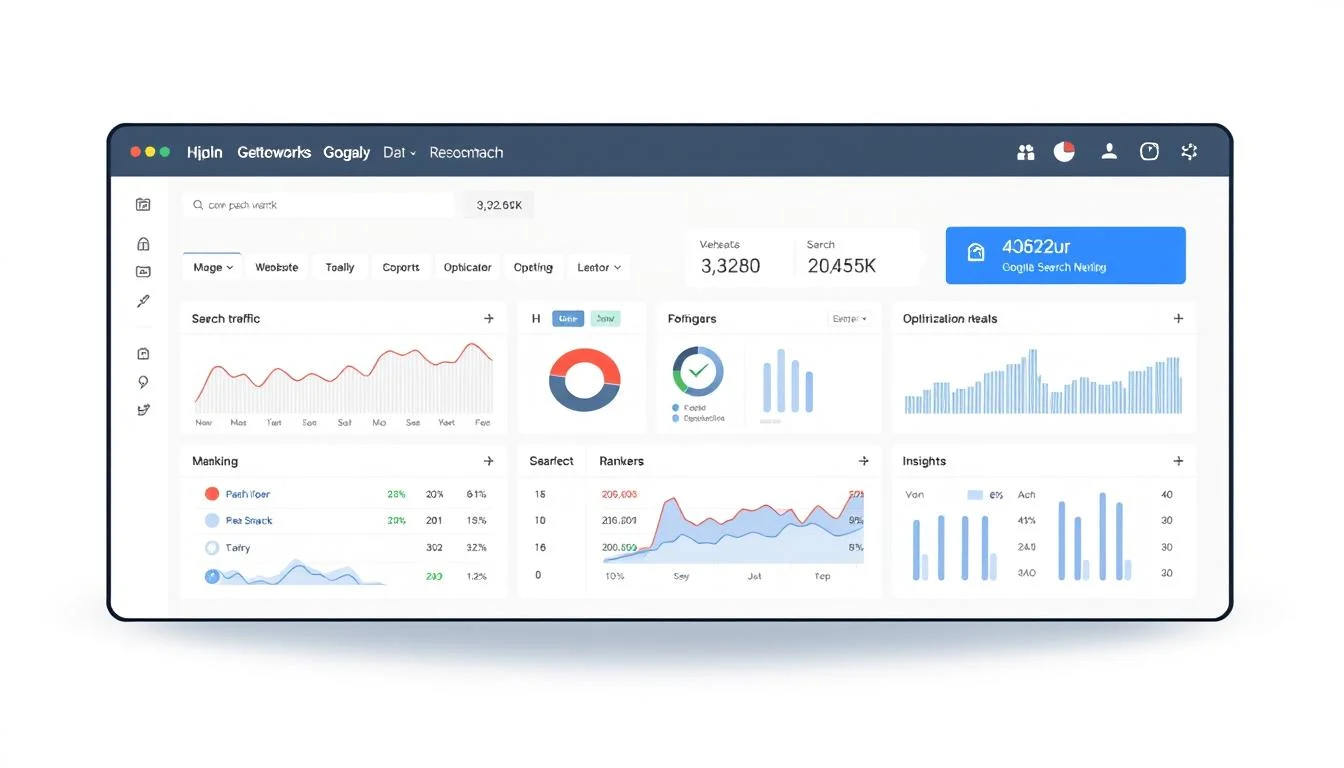
Identifying and Tracking Key SEO Metrics
The best SEO strategies focus on metrics that impact your business. I prioritize data that shows how SEO drives revenue and growth.
Moz says setting KPIs is key to measuring SEO’s return on investment. It suggests documenting your primary SEO KPIs for success.
Here are the essential metrics I track for every client:
- Organic traffic growth – The number of visitors from search engines
- Keyword rankings – Your ranking for target keywords
- Conversion rates from organic traffic – The percentage of search visitors who complete desired actions
- Click-through rates (CTR) – How often people click your search results
- Average session duration from organic visitors – How engaged your search traffic is
I track keywords where you want to rank well because they impact your search visibility. Monitoring your progress helps you see if your optimization works.
Analyzing Your Competitors’ SEO Performance
Understanding your competitors is key to your SEO success. I regularly analyze competitors to find opportunities and gaps in my strategy.
Competitive analysis shows why some websites rank higher. By studying their strategies, you can improve your own.
The most valuable insights I get include:
- Which keywords competitors rank for that you don’t
- Content topics that generate high search traffic in your industry
- Technical SEO implementations that give competitors advantages
- Backlink strategies that build their domain authority
Tools I Recommend for SEO Analysis
Professional seo tools make analysis and tracking easier than manual methods. I’ve tested many and recommend these for their accuracy and usefulness.
For detailed competitive research, I use tools like SEMrush. It shows competitors’ keyword rankings and traffic sources. You see which keywords drive traffic to competitors and estimate their search volume.
Ahrefs is great for backlink analysis. It helps you understand how competitors build their authority. You’ll see which websites link to competitors and find link-building opportunities for your site.
Screaming Frog crawls your site like a search engine and finds technical issues. This desktop tool helps you find broken links, duplicate content, and other problems.
| Tool | Primary Function | Best For | Pricing Model |
|---|---|---|---|
| SEMrush | Competitive Research | Keyword analysis and competitor insights | Monthly subscription |
| Ahrefs | Backlink Analysis | Link building and domain authority | Monthly subscription |
| Screaming Frog | Technical Audits | Site crawling and technical issues | Free/Paid versions |
| Google Analytics | User Behavior | Traffic analysis and conversions | Free |
Managing SEO measurement and optimization can be complex. If you want to boost your SEO success, consider working with experts. You can find qualified SEO specialists through reputable freelancer platforms where they offer tailored services for your business.
Essential SEO Components That Prove Its Importance
SEO is key for business success. It helps businesses reach their audience online. The core elements of SEO make this possible.
SEO boosts website visibility in many ways. It makes your site easy for search engines to understand. This approach leads to lasting results for businesses that optimize well.
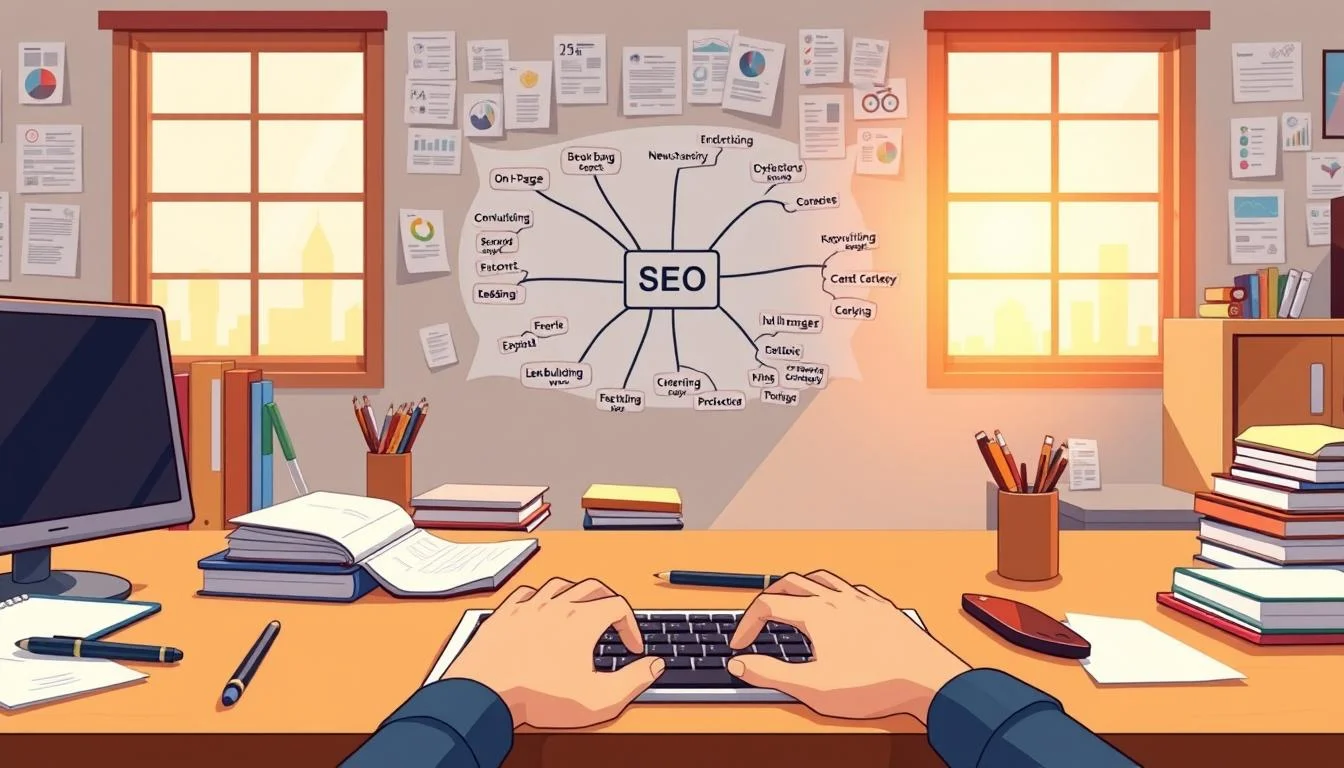
On-Page SEO: Optimizing Content and Structure
On-page SEO is the base of a good strategy. I control elements on my site to improve rankings. This makes my site user-friendly and relevant to search engines.
How your site is structured matters a lot. Search engines check if your pages answer user questions well. This affects where your site shows up in search results.
Keyword Research and Implementation
Keyword research is vital for SEO. I find out what terms my audience uses. This helps connect my business with customers.
Today, keyword use is more than just adding words. I focus on creating content that answers user needs. This makes each piece of content valuable to searchers.
It’s important to use keywords naturally. I make sure they fit well in the content. This helps search engines see the topic’s relevance and keeps the content easy to read.
Meta Tags and Content Optimization
Meta tags are key for talking to search engines. I write title tags and meta descriptions that describe the page well. This helps with rankings and click-through rates.
Optimizing content makes it better for users and search engines. I use header tags and clear formatting. This makes the content easy to scan and understand.
| On-Page Element | Primary Function | SEO Impact | User Benefit |
|---|---|---|---|
| Title Tags | Page identification | High ranking factor | Clear page purpose |
| Header Tags | Content structure | Topic organization | Easy navigation |
| Meta Descriptions | Search snippets | Click-through rates | Content preview |
| Internal Links | Site navigation | Page authority distribution | Related content discovery |
Technical SEO: The Foundation of Search Success
Technical SEO is the base of SEO success. It’s the foundation for all other efforts. Without it, even great content can’t rank well.
Search engines need to crawl and index your site well. Technical SEO makes this possible. It helps your site compete in search results.
Site Speed and Core Web Vitals
Page speed is now a key ranking factor. Google’s Core Web Vitals measure user experience. These metrics affect rankings and user satisfaction.
I improve site speed through various methods. Fast sites rank better and offer better user experiences. This leads to more engagement and conversions.
Core Web Vitals show Google’s focus on user experience. I keep an eye on these metrics to meet Google’s standards. This shows why SEO needs ongoing work.
Mobile Responsiveness and Crawlability
Mobile-first indexing means Google ranks mobile versions first. I make sure all sites work well on all devices. This reflects how most people use the internet.
Crawlability lets search engines find and access your site. I create clear structures and use internal links. This helps search engines understand and rank your pages.
Technical SEO is key because even great content is invisible without it. I aim to make sites that are good for users and search engines. This ensures quality content reaches its audience.
SEO components work together for success. By mastering on-page and technical SEO, I can attract organic traffic. This supports business growth.
Local SEO: Why It’s Critical for Small and Local Businesses
Local SEO connects businesses with customers who need something right away. When someone searches for “coffee shop near me” or “emergency plumber,” they’re looking for something specific. They want it fast and nearby.
Small businesses see a big boost in revenue by focusing on local SEO. Unlike traditional SEO, local SEO targets customers in your area. This means you get more people visiting your business or using your services.
Local SEO boosts foot traffic and phone calls right away. When people search for things in their neighborhood, you want to be the first they see. Google handles over 46% of all local searches, making local SEO key for success.
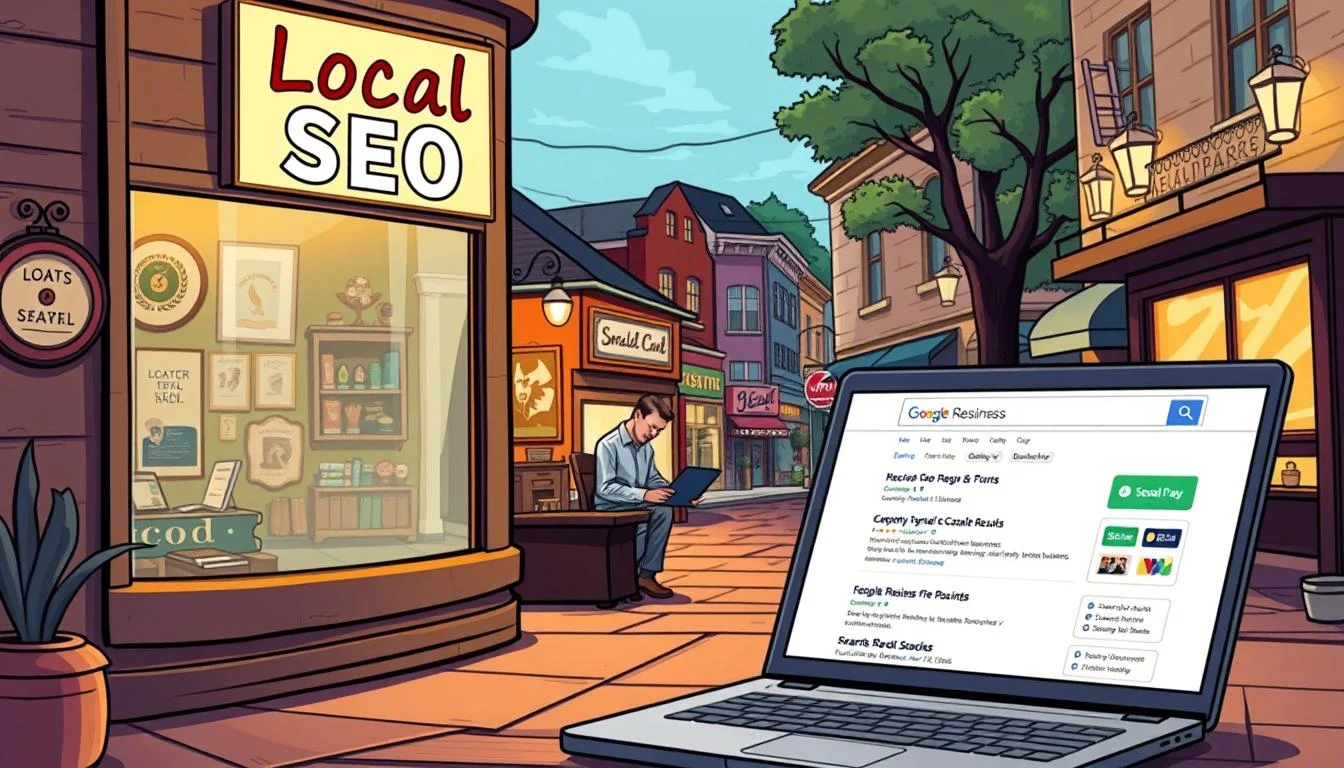
Google Business Profile Optimization Tutorial
Your Google Business Profile is like a digital storefront. I start here to boost your local visibility. This free tool from Google helps you show up in search results when people look for your services.
I make sure every section of your profile is filled out. Your business name, address, and phone number must match everywhere. I also upload high-quality photos of your storefront, products, and team.
Next, I work on your business description and categories. Choosing the right category is important for your rankings. I write descriptions that include keywords and highlight what makes your business unique. Regular updates keep your profile active and engaging.
Business hours are critical. I verify they’re correct and update them for holidays or special events. Wrong hours can frustrate customers and hurt your rankings.
The Q&A section is another chance to find information customers seek. It’s a great way to answer common questions.
Local Search Ranking Factors You Must Know
Google uses three main factors for local search rankings: relevance, distance, and prominence. Knowing these helps me optimize your business for better results.
Relevance is how well your business matches the search query. I make sure your business listings have all the information about your services. Your website should clearly explain what you do and who you serve.
Distance is how close your business is to the searcher. While you can’t change your address, I help you create location-specific landing pages. This expands your reach without losing local authority.
Prominence combines your offline reputation with online signals. I track mentions of your business and monitor reviews. Google and Bing reward businesses with consistent information across directories.
Customer reviews are very important for local rankings. I help you get more reviews from happy customers. Responding to all reviews shows you care and improves your rankings.
Building Local Citations and Reviews
Local citations are online mentions of your business information. They’re key for credibility with search engines. I start by claiming your business on major directories like Yelp and Yellow Pages.
Consistency is key in citation building. I use a master document for all directory submissions. Small mistakes in your address or phone number can confuse search engines.
I focus on quality directories over quantity. Local chamber of commerce websites and industry associations are more valuable than generic sites. They carry more weight with search engines and drive direct traffic.
Review management needs ongoing effort and strategy. I help you get reviews from happy customers through emails and in-person requests. The goal is a steady stream of authentic reviews.
Responding to reviews shows your customer service. I always respond within 24-48 hours. Thanking customers for positive feedback and addressing concerns in negative reviews helps turn them into positives.
✨ Tired of Low Rankings? This Freelance SEO Specialist Can Fix That Fast
The Consequences of Ignoring SEO: Real-World Examples
I’ve seen how businesses fail when they ignore search engine optimization techniques. The digital graveyard is full of companies that didn’t invest in seo efforts. These examples show the dangers of neglecting search visibility.
Ignoring SEO leads to more than just ranking drops. Companies lose customers, revenue, and market share. Competitors who focus on good seo gain an advantage. Most of these failures could have been avoided with proper planning.
What Happens When Businesses Skip SEO
Ignoring basic seo makes a business invisible to its audience. I’ve seen long-standing companies struggle to attract new customers. They failed to adapt to digital search behaviors.
Businesses that rely only on word-of-mouth marketing struggle. Referrals are valuable but can’t grow a business in today’s market. Companies that ignore seo work face:
- Dramatic decreases in website traffic and lead generation
- Loss of market share to competitors who invest in search optimization
- Increased dependency on expensive paid advertising channels
- Difficulty establishing credibility with younger, digitally-savvy consumers
The financial impact can be severe. Moz warns that penalized websites can bankrupt businesses. This shows why ongoing seo is not optional—it’s essential for survival.

Common SEO Mistakes and Their Impact
Even businesses trying SEO make mistakes that harm them. I’ve seen companies suffer ranking drops due to technical issues they didn’t know about.
Common mistakes include poor mobile optimization, slow loading speeds, and broken internal links. These problems signal to search engines that a website doesn’t follow best practices. This leads to lower rankings and reduced visibility.
Content-related mistakes are also damaging. Stuffing keywords unnaturally into content can trigger penalties. This requires extensive recovery efforts.
Black Hat SEO Practices to Avoid
Google and Bing guidelines warn against black hat seo practices. These include automatically generated content, link schemes, and keyword stuffing. These tactics can destroy a business’s online presence.
These shortcuts promise quick results but are detected by search engines. When caught, penalties can be severe.
I’ve seen businesses lose 90% of their organic traffic overnight due to black hat seo penalties. Some never recover, while others spend years and thousands of dollars trying to rebuild their search presence.
Recovery Strategies for SEO Penalties
Recovering from SEO penalties requires seo work and patience. The process involves website overhauls, content audits, and link cleanup campaigns. This can take months or years.
The first step is identifying the penalty and its cause. This requires analyzing search console data and conducting technical audits. Many businesses need professional help at this stage.
Once the issues are identified, the real work begins. Recovery strategies include:
- Removing or disavowing harmful backlinks
- Rewriting content that violates quality guidelines
- Fixing technical issues that impact user experience
- Implementing proper best practices throughout the website
- Submitting reconsideration requests when appropriate
Forbes notes that SEO is worth the time and effort. It’s more cost-effective to invest in good seo from the start than to try to recover from penalties.
The key lesson is simple: proper seo efforts and following guidelines from the start are more affordable and effective. Prevention is the best medicine in SEO.
📉 If Your Site Isn’t Ranking, You’re Losing Money — This SEO Pro Can Help
Building Your SEO Strategy: A Practical Implementation Guide
Creating a solid SEO plan needs careful planning, realistic timelines, and sometimes expert advice to hit your important goals. Many businesses dive into SEO without a plan, wasting resources and getting disappointing results. A well-thought-out seo strategy is your roadmap to success.
Understanding where you stand and where you want to go is key to good SEO. This means checking your website’s performance, looking at your competitors, and setting clear goals. Let me show you the essential steps to change how you approach SEO.
Conducting a Complete SEO Audit
Your SEO audit is the base of everything that follows. I start by checking your website’s current state before making any suggestions. This detailed review shows both chances and obstacles that affect your ability to improve search rankings.
The audit covers many areas. You need to look at technical performance, content quality, and how you compare to competitors. Each part gives important insights that shape your seo strategy ahead.
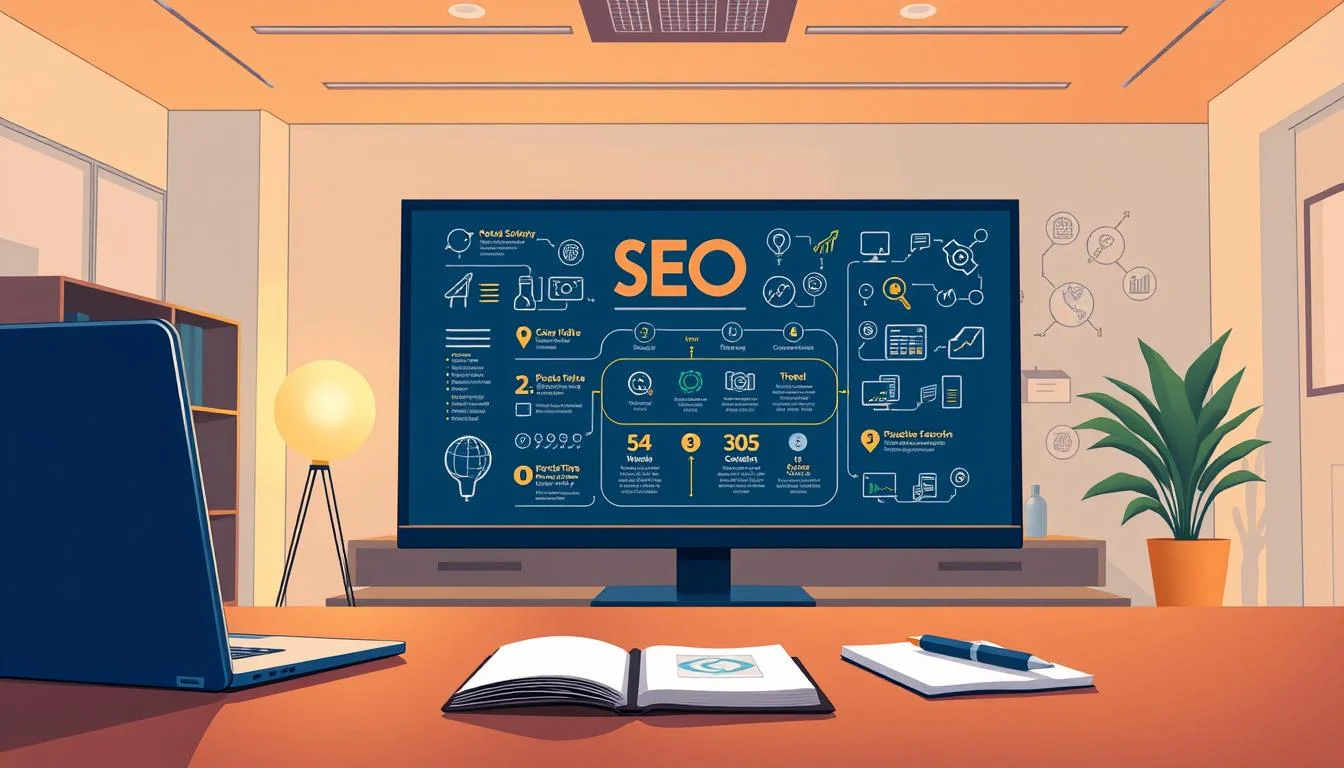
Technical problems often stop websites from reaching their full via search engine capabilities. I suggest following a detailed checklist to find and fix common issues:
| Technical Element | What to Check | Impact Level | Priority |
|---|---|---|---|
| Site Speed | Page load times under 3 seconds | High | Critical |
| Mobile Responsiveness | Mobile-friendly design and functionality | High | Critical |
| XML Sitemaps | Proper sitemap structure and submission | Medium | Important |
| Crawl Errors | 404 errors and broken internal links | Medium | Important |
| Duplicate Content | Content duplication across pages | Medium | Moderate |
Using sitemaps correctly helps search engines understand your website’s structure. I always make sure XML sitemaps are updated regularly and sent to Google Search Console. This simple step greatly improves how search engines crawl and index your content.
Google says some changes might take a few hours, while others could take months. They suggest waiting a few weeks to see if changes are beneficial.
Content Gap Analysis
Content gap analysis shows where your competitors rank but you don’t. This involves checking how search engines evaluate content relevance and finding topics that match your business goals.
I look at competitor content to see what makes their pages successful. This includes checking keyword use, content depth, and user engagement signals. These insights guide your content marketing strategy and help decide what content to create next.
Focus on topics that match your expertise and what your audience needs. Quality content that answers specific user questions does better than generic info. Your seo team should prioritize content that serves both search engines and real users well.
Creating Your SEO Implementation Timeline
Realistic timelines prevent frustration and ensure steady progress toward your important goals. I suggest breaking your seo strategy into phases that build on each other systematically.
Start with technical fixes that provide immediate improvements. These changes often show results within weeks and create a solid foundation for future efforts. Next, focus on content optimization and creation, which typically takes longer to impact rankings.
Link building activities should come last in your timeline. This approach ensures that you’re promoting high-quality, optimized content that deserves to rank well. Remember that seo as well requires patience and consistent effort over time.
When to Hire Professional SEO Services
Many businesses reach a point where they can’t handle the complexity of modern SEO on their own. Professional seo services are valuable when you need specialized expertise or don’t have time to manage a full campaign.
Consider hiring professionals if your website has technical issues beyond your team’s skills. Complex sites often need advanced knowledge of server setup, schema markup, and performance optimization. An experienced seo team can tackle these challenges efficiently.
Moz stresses the importance of knowing your website goals before starting a strategic SEO plan. They also warn about the variation in quality among SEO agencies and consultants.
Moz
Budget considerations also play a role in this decision. Professional services require an investment, but they often lead to faster results than learning everything yourself. Calculate the opportunity cost of delayed results versus the cost of expert help.
Finding the Right SEO Expert for Your Needs
Choosing the right professional is key to success. I suggest evaluating possible partners based on their approach, experience, and communication style.
Look for experts who focus on white-hat techniques and provide clear reports. Avoid anyone promising overnight success or guaranteed rankings. Real professionals know that sustainable SEO takes time and consistent effort.
Ask for case studies and references from similar businesses. The best seo services providers can show measurable results and explain their methods clearly. They should also understand your industry and target audience.
For businesses ready to invest in professional expertise, you can find qualified SEO specialists on reputable freelancing platforms where experienced professionals offer their services. These platforms let you review portfolios, read client feedback, and compare different approaches to find the perfect match for your needs.
Remember, effective content marketing and SEO work together to improve search visibility over time. The right professional partner will help you navigate this complex landscape and achieve lasting results that support your business growth.
Conclusion
SEO is a smart investment for your business’s digital future. It helps you rank higher in search results, creating lasting value. Forbes says SEO boosts brand awareness at a low cost. Moz highlights how it leads to real success, not just numbers.
SEO is sustainable. Unlike paid ads, your search engine visibility keeps working even after you stop paying. When someone searches for your services and finds your site, you’ve caught them at the right time.
SEO builds trust with your audience. People trust brands they find through organic search more than those in ads. This trust leads to better conversion rates and loyal customers.
Start with the basics, stay consistent, and offer real value. Businesses that rank well in search will lead their markets soon. Your website can be a powerful growth driver, even when you’re not working.
Related Articles:
- What is Generative Engine Optimization (GEO): The Revolutionary Shift in SEO?
- Why is Search Engine Marketing Important? : Essential Benefits & Winning Strategies
- Local Search Engine Optimization Guide: Improve Your Local SEO Ranking
- eCommerce SEO Service: Your Top eCommerce SEO Agency for Online Retailers
- Video SEO Service: YouTube Search Engine Optimization, Boost Your Online Visibility
This post contains affiliate links, which means I may earn a commission if you make a purchase through these links. There is no additional charge to you! Thank you for supporting my blog so I can continue creating free content each week!

